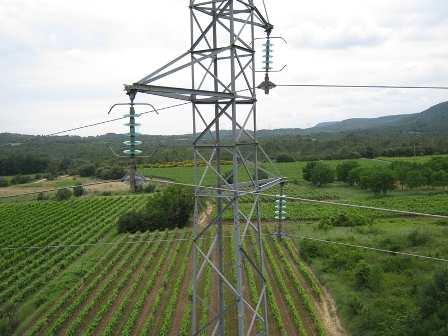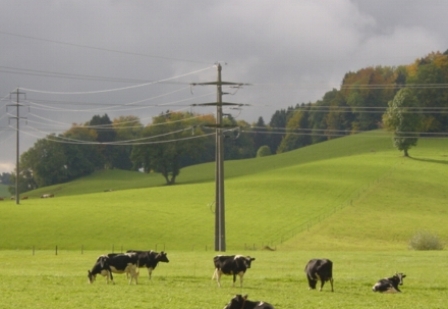Protected areas of power lines and the rules for their residence
The protection zone of power lines is an area located on both sides of the power line, in the form of a plot of land, water space, which also includes the air space above this section. The size of the protection zone depends on the location of the power line (on land, through the water body), its design (cable or overhead), its purpose (power line or communication line), the voltage class of the line.
Any work performed in the protective zone of power lines is one of the activities that expose the employee to increased danger to life or harm to health.
We give the value of the boundaries of the security zones of cable and overhead lines, depending on the given criteria.
The protective zone of overhead power lines passing above ground changes depending on the voltage of these lines.For overhead lines with a voltage of up to 1000 V, including communication lines, the security zone is a plot of land and air space along the line along its entire length, at a distance of at least two meters on both sides of this line; for high-voltage overhead lines of voltage class 6 and 10 kV, this distance is 10 m; for overhead lines -35 kV — 15 m; for overhead lines 110 kV — 20 m, etc.
For cable power lines laid in the ground, the safety zone is one meter from the place where the outermost cable is laid, regardless of its voltage. For a cable communication line, this distance is 2 m.
Both overhead and cable lines along their entire length can pass through various reservoirs, while the protected area extends to these sections of the power line. For overhead lines that cross non-navigable bodies of water, the size of the buffer zone is the same as for other sections of that overhead line passing over land. When the line passes through navigable bodies of water, the buffer zone, regardless of the voltage value, is 100 m.
The protective zone of the cable lines laid along the bottom of the tanks is 100 m in all cases.

Human activities in the safety zone of power lines
Why was the concept of security zone for power lines introduced? First of all, to ensure the safety of people in connection with possible electric shock, injury in case of damage to this line, as well as to prevent possible negative effects of electromagnetic radiation on the human body.
In accordance with statistics and research results, it has been established that the prolonged presence of a person in the protective zone of power lines leads to disruption of the activity of the cardiovascular, nervous, endocrine, neurohormonal, immune and other systems and organs of the human body.
The construction of any buildings and facilities is prohibited in the protection zone of the power line. At the same time, the plots on which the power lines pass are not withdrawn from the owners, they can be exploited, but with certain restrictions, depending on local conditions and the plug of the passing lines.
For example, if a cable line passes through the territory of a landed property and the owner of this landed property plans to carry out excavation works, then he must take into account that such works are prohibited in the security zone of a passing cable line.
If the plot will be used for growing agricultural crops, it should be taken into account that the power line passing through the territory of the plot may be damaged and the repair team, removing the damage, will take away part of the cultivated crops that have become unusable.
The restriction of activities in the safety zone of the lines is due not only to the safety of people, but also to the need to prevent possible damage to the lines, disruption of their normal operation. Below are the restrictions on activities in the security zone of power lines .
It is prohibited in the security zone of the power line:
-
to carry out blasting, excavation, reclamation works;
-
tree planting;
-
store garbage, soil, straw, snow, etc.;
-
watering crops, pouring aggressive substances that can lead to the destruction of cable lines or supports of overhead lines;
-
closing the existing entrances to power lines;
-
allow long-term human presence;
-
carry out any actions that may lead to disruption of the normal operation of electrical networks;
-
to carry out installation / dismantling of various structures, buildings, constructions, communications without prior agreement with the organization serving power lines passing near the place of planned work.
When drawing up documents for a new piece of land with a power line running through it, or when planning any work, it is necessary to obtain permission from an organization that maintains these electrical networks. Particular attention should be paid to the cable lines, which are very often found only in case of accidental damage during the excavation of the site.

Rules for staying in the security area of power lines
If we talk about the harm from electromagnetic radiation from power lines, then in this case, the further a person is from the power line, the less he is exposed to negative effects of electromagnetic radiation… Therefore, it is necessary, if possible, to be as far as possible from the passage of high voltage power lines or to reduce the time spent in the zone of possible electromagnetic radiation.
Power lines are a deadly hazard, especially high voltage power lines. Therefore, in the immediate vicinity of power lines, you must adhere to the following safety rules.
Do not go near a bare wire lying on the ground, as there is a good chance that it is live. If a person approaches the wire at a distance of less than eight meters, then he will be affected by step voltage and will be electrocuted. If the wire is at a distance of less than 8 m from a person, then you must leave the danger zone, moving on a "goose step", without lifting your legs from each other.
It should also be remembered that there is such a concept as the permissible distance to parts of an electrical installation that are under operating voltage. For example, if exposed wires are too sagged, a person will be electrocuted when approaching them at an unacceptable distance.
It is prohibited to approach power lines that are in an emergency state or have signs of damage. For example, if a crackling is heard, an electric arc is seen, then the line can be damaged at any time and cause harm to a person.
